Curriculum: Definition, Design, Implementation, and Evaluation
VerifiedAdded on 2021/05/31
|15
|4293
|27
Essay
AI Summary
This essay provides a comprehensive exploration of the concept of curriculum within the context of educational institutions. It begins by defining curriculum as more than just a list of topics, encompassing the entire scope of an educational program and the strategies for its implementation. The essay delves into the various facets of curriculum, including its design, implementation, and evaluation, highlighting its central role in learning and teaching processes across different educational sectors. It examines different curriculum designs such as subject-centered, learner-centered, and problem-centered approaches, discussing their characteristics, strengths, and weaknesses. The essay also touches on the importance of curriculum in meeting the diverse needs of students, communities, and workplaces, emphasizing its adaptability and the significance of aims, objectives, and content organization within a curriculum. Furthermore, the essay addresses curriculum development as a process of change and adaptation, and the role of teachers in shaping and refining curricula to enhance student learning. Overall, the essay underscores the critical role of curriculum in guiding and facilitating effective learning experiences.
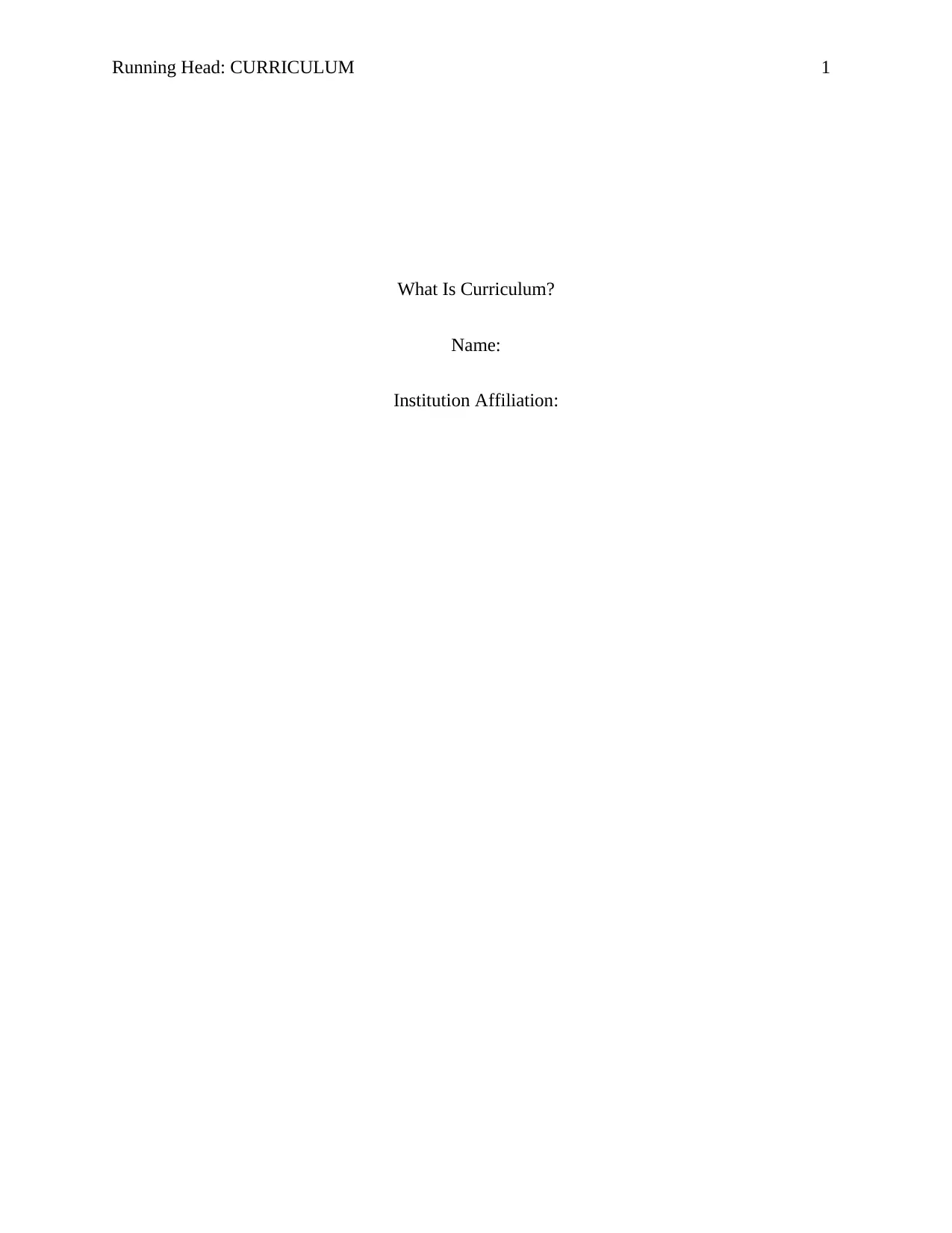
Running Head: CURRICULUM 1
What Is Curriculum?
Name:
Institution Affiliation:
What Is Curriculum?
Name:
Institution Affiliation:
Paraphrase This Document
Need a fresh take? Get an instant paraphrase of this document with our AI Paraphraser
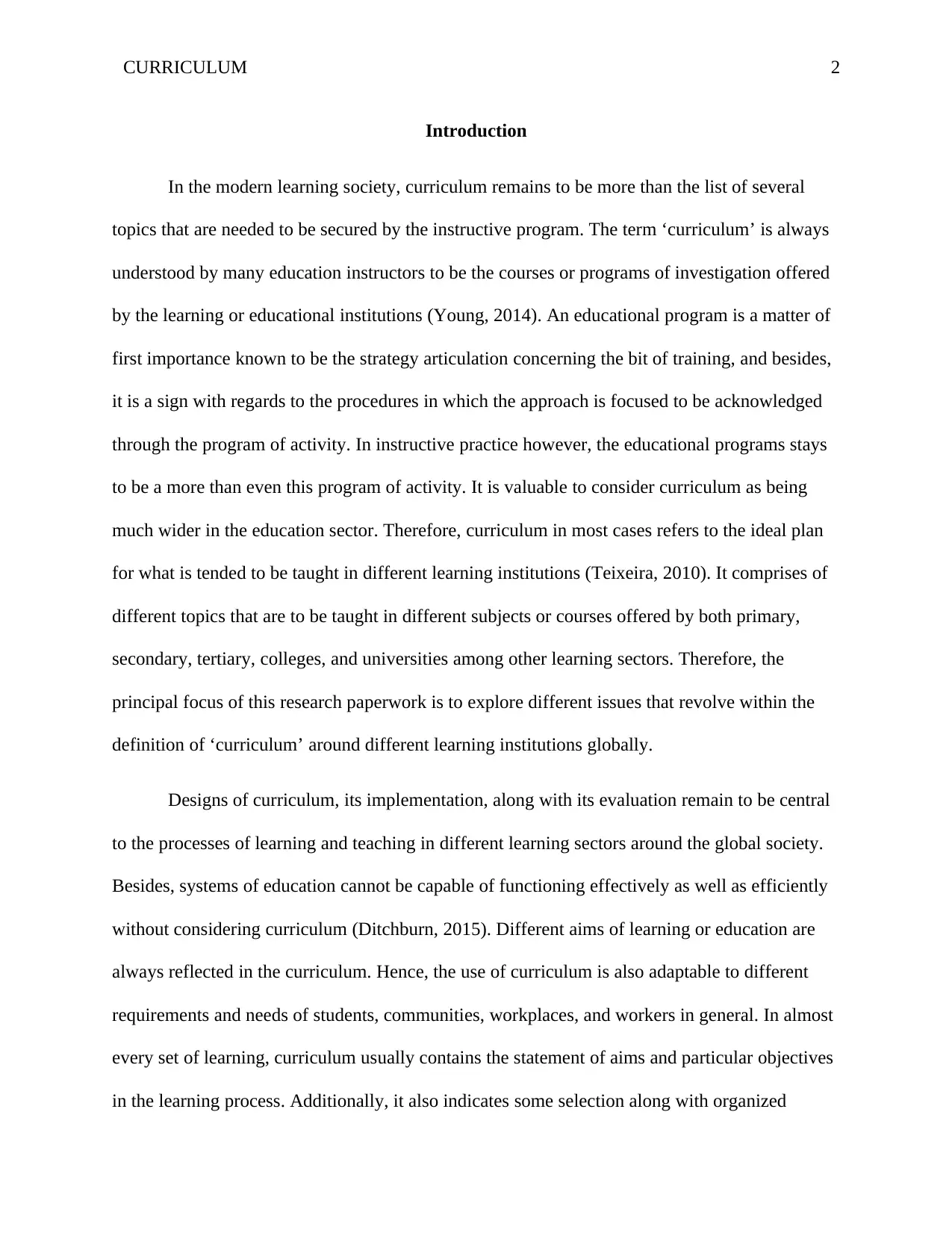
CURRICULUM 2
Introduction
In the modern learning society, curriculum remains to be more than the list of several
topics that are needed to be secured by the instructive program. The term ‘curriculum’ is always
understood by many education instructors to be the courses or programs of investigation offered
by the learning or educational institutions (Young, 2014). An educational program is a matter of
first importance known to be the strategy articulation concerning the bit of training, and besides,
it is a sign with regards to the procedures in which the approach is focused to be acknowledged
through the program of activity. In instructive practice however, the educational programs stays
to be a more than even this program of activity. It is valuable to consider curriculum as being
much wider in the education sector. Therefore, curriculum in most cases refers to the ideal plan
for what is tended to be taught in different learning institutions (Teixeira, 2010). It comprises of
different topics that are to be taught in different subjects or courses offered by both primary,
secondary, tertiary, colleges, and universities among other learning sectors. Therefore, the
principal focus of this research paperwork is to explore different issues that revolve within the
definition of ‘curriculum’ around different learning institutions globally.
Designs of curriculum, its implementation, along with its evaluation remain to be central
to the processes of learning and teaching in different learning sectors around the global society.
Besides, systems of education cannot be capable of functioning effectively as well as efficiently
without considering curriculum (Ditchburn, 2015). Different aims of learning or education are
always reflected in the curriculum. Hence, the use of curriculum is also adaptable to different
requirements and needs of students, communities, workplaces, and workers in general. In almost
every set of learning, curriculum usually contains the statement of aims and particular objectives
in the learning process. Additionally, it also indicates some selection along with organized
Introduction
In the modern learning society, curriculum remains to be more than the list of several
topics that are needed to be secured by the instructive program. The term ‘curriculum’ is always
understood by many education instructors to be the courses or programs of investigation offered
by the learning or educational institutions (Young, 2014). An educational program is a matter of
first importance known to be the strategy articulation concerning the bit of training, and besides,
it is a sign with regards to the procedures in which the approach is focused to be acknowledged
through the program of activity. In instructive practice however, the educational programs stays
to be a more than even this program of activity. It is valuable to consider curriculum as being
much wider in the education sector. Therefore, curriculum in most cases refers to the ideal plan
for what is tended to be taught in different learning institutions (Teixeira, 2010). It comprises of
different topics that are to be taught in different subjects or courses offered by both primary,
secondary, tertiary, colleges, and universities among other learning sectors. Therefore, the
principal focus of this research paperwork is to explore different issues that revolve within the
definition of ‘curriculum’ around different learning institutions globally.
Designs of curriculum, its implementation, along with its evaluation remain to be central
to the processes of learning and teaching in different learning sectors around the global society.
Besides, systems of education cannot be capable of functioning effectively as well as efficiently
without considering curriculum (Ditchburn, 2015). Different aims of learning or education are
always reflected in the curriculum. Hence, the use of curriculum is also adaptable to different
requirements and needs of students, communities, workplaces, and workers in general. In almost
every set of learning, curriculum usually contains the statement of aims and particular objectives
in the learning process. Additionally, it also indicates some selection along with organized
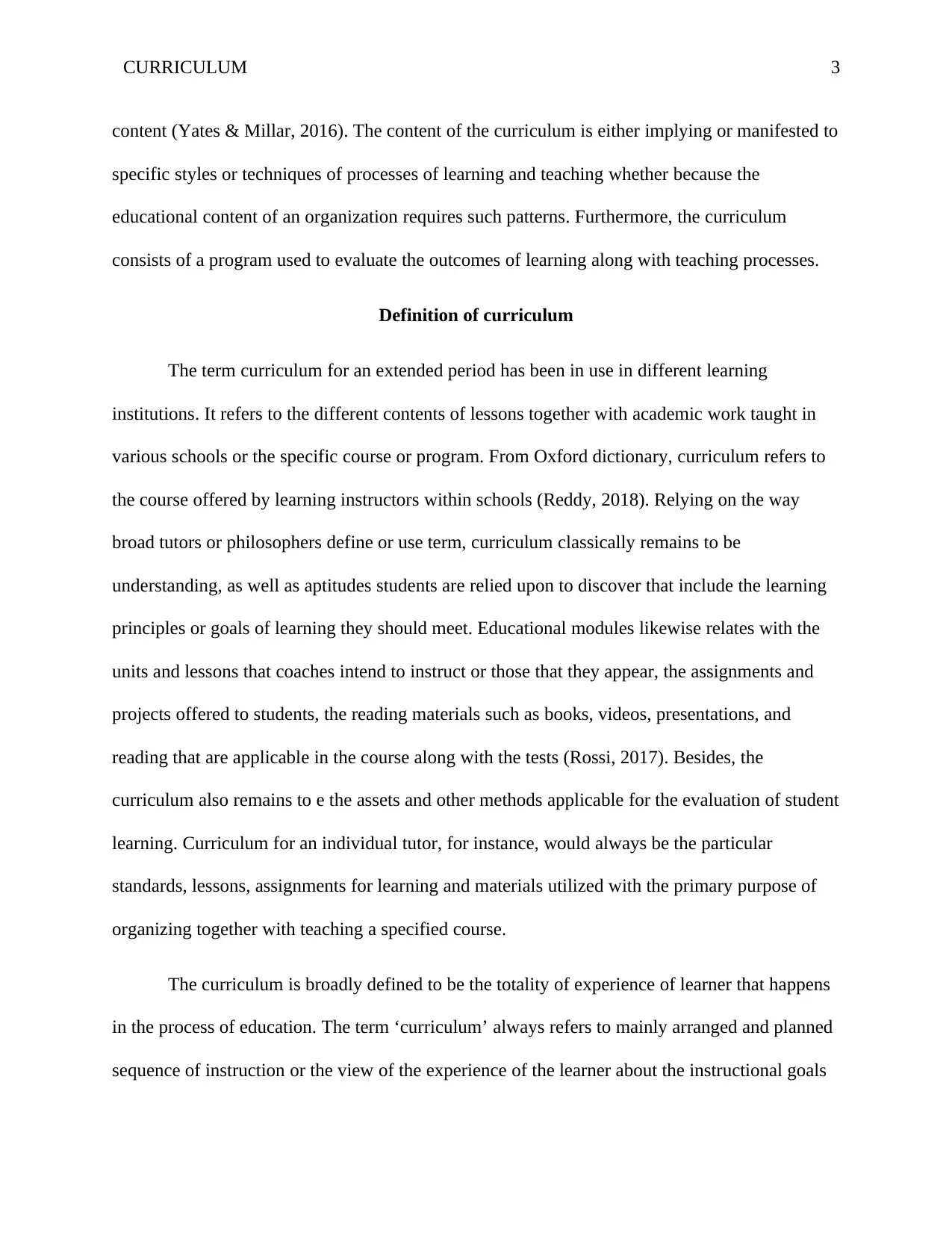
CURRICULUM 3
content (Yates & Millar, 2016). The content of the curriculum is either implying or manifested to
specific styles or techniques of processes of learning and teaching whether because the
educational content of an organization requires such patterns. Furthermore, the curriculum
consists of a program used to evaluate the outcomes of learning along with teaching processes.
Definition of curriculum
The term curriculum for an extended period has been in use in different learning
institutions. It refers to the different contents of lessons together with academic work taught in
various schools or the specific course or program. From Oxford dictionary, curriculum refers to
the course offered by learning instructors within schools (Reddy, 2018). Relying on the way
broad tutors or philosophers define or use term, curriculum classically remains to be
understanding, as well as aptitudes students are relied upon to discover that include the learning
principles or goals of learning they should meet. Educational modules likewise relates with the
units and lessons that coaches intend to instruct or those that they appear, the assignments and
projects offered to students, the reading materials such as books, videos, presentations, and
reading that are applicable in the course along with the tests (Rossi, 2017). Besides, the
curriculum also remains to e the assets and other methods applicable for the evaluation of student
learning. Curriculum for an individual tutor, for instance, would always be the particular
standards, lessons, assignments for learning and materials utilized with the primary purpose of
organizing together with teaching a specified course.
The curriculum is broadly defined to be the totality of experience of learner that happens
in the process of education. The term ‘curriculum’ always refers to mainly arranged and planned
sequence of instruction or the view of the experience of the learner about the instructional goals
content (Yates & Millar, 2016). The content of the curriculum is either implying or manifested to
specific styles or techniques of processes of learning and teaching whether because the
educational content of an organization requires such patterns. Furthermore, the curriculum
consists of a program used to evaluate the outcomes of learning along with teaching processes.
Definition of curriculum
The term curriculum for an extended period has been in use in different learning
institutions. It refers to the different contents of lessons together with academic work taught in
various schools or the specific course or program. From Oxford dictionary, curriculum refers to
the course offered by learning instructors within schools (Reddy, 2018). Relying on the way
broad tutors or philosophers define or use term, curriculum classically remains to be
understanding, as well as aptitudes students are relied upon to discover that include the learning
principles or goals of learning they should meet. Educational modules likewise relates with the
units and lessons that coaches intend to instruct or those that they appear, the assignments and
projects offered to students, the reading materials such as books, videos, presentations, and
reading that are applicable in the course along with the tests (Rossi, 2017). Besides, the
curriculum also remains to e the assets and other methods applicable for the evaluation of student
learning. Curriculum for an individual tutor, for instance, would always be the particular
standards, lessons, assignments for learning and materials utilized with the primary purpose of
organizing together with teaching a specified course.
The curriculum is broadly defined to be the totality of experience of learner that happens
in the process of education. The term ‘curriculum’ always refers to mainly arranged and planned
sequence of instruction or the view of the experience of the learner about the instructional goals
⊘ This is a preview!⊘
Do you want full access?
Subscribe today to unlock all pages.

Trusted by 1+ million students worldwide
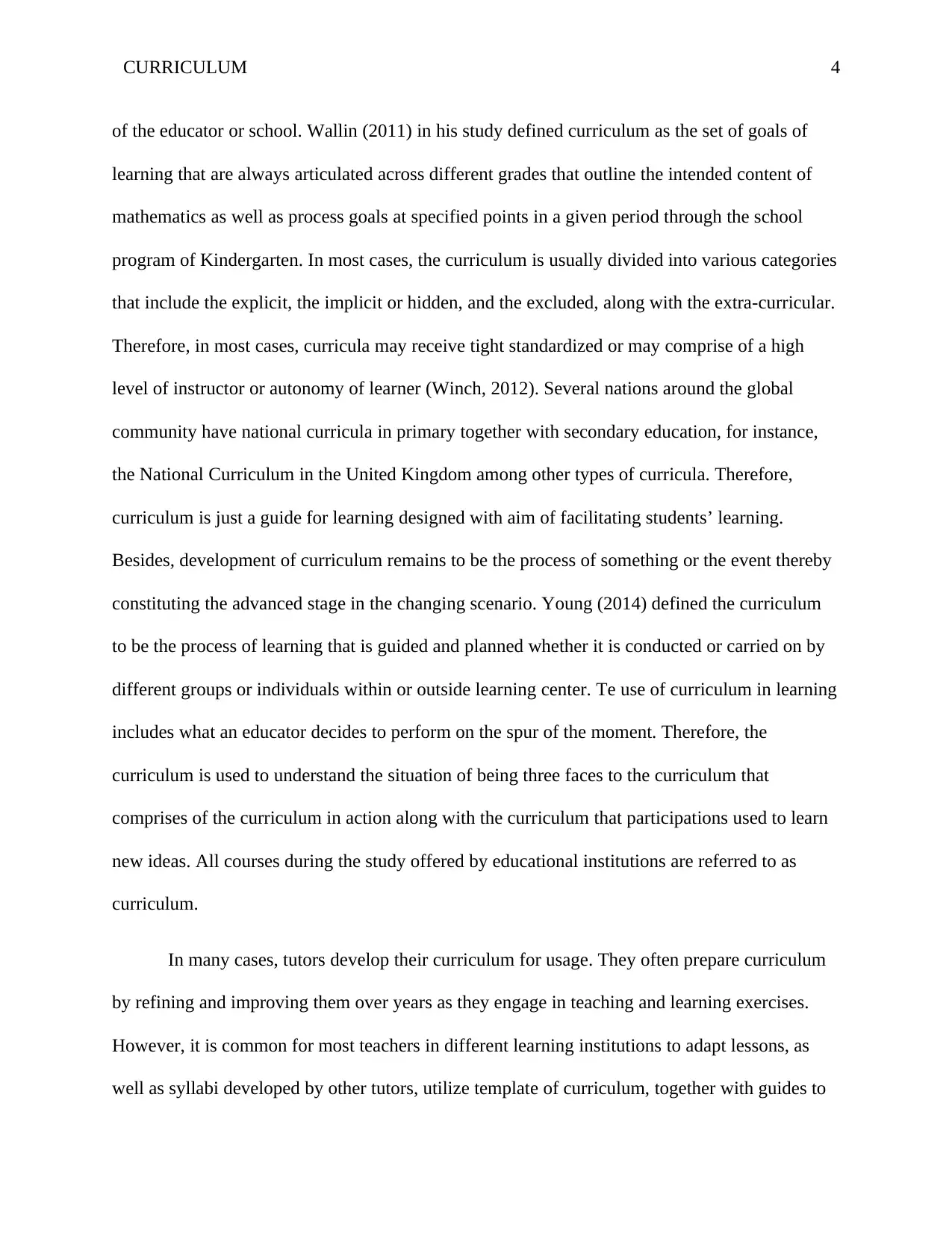
CURRICULUM 4
of the educator or school. Wallin (2011) in his study defined curriculum as the set of goals of
learning that are always articulated across different grades that outline the intended content of
mathematics as well as process goals at specified points in a given period through the school
program of Kindergarten. In most cases, the curriculum is usually divided into various categories
that include the explicit, the implicit or hidden, and the excluded, along with the extra-curricular.
Therefore, in most cases, curricula may receive tight standardized or may comprise of a high
level of instructor or autonomy of learner (Winch, 2012). Several nations around the global
community have national curricula in primary together with secondary education, for instance,
the National Curriculum in the United Kingdom among other types of curricula. Therefore,
curriculum is just a guide for learning designed with aim of facilitating students’ learning.
Besides, development of curriculum remains to be the process of something or the event thereby
constituting the advanced stage in the changing scenario. Young (2014) defined the curriculum
to be the process of learning that is guided and planned whether it is conducted or carried on by
different groups or individuals within or outside learning center. Te use of curriculum in learning
includes what an educator decides to perform on the spur of the moment. Therefore, the
curriculum is used to understand the situation of being three faces to the curriculum that
comprises of the curriculum in action along with the curriculum that participations used to learn
new ideas. All courses during the study offered by educational institutions are referred to as
curriculum.
In many cases, tutors develop their curriculum for usage. They often prepare curriculum
by refining and improving them over years as they engage in teaching and learning exercises.
However, it is common for most teachers in different learning institutions to adapt lessons, as
well as syllabi developed by other tutors, utilize template of curriculum, together with guides to
of the educator or school. Wallin (2011) in his study defined curriculum as the set of goals of
learning that are always articulated across different grades that outline the intended content of
mathematics as well as process goals at specified points in a given period through the school
program of Kindergarten. In most cases, the curriculum is usually divided into various categories
that include the explicit, the implicit or hidden, and the excluded, along with the extra-curricular.
Therefore, in most cases, curricula may receive tight standardized or may comprise of a high
level of instructor or autonomy of learner (Winch, 2012). Several nations around the global
community have national curricula in primary together with secondary education, for instance,
the National Curriculum in the United Kingdom among other types of curricula. Therefore,
curriculum is just a guide for learning designed with aim of facilitating students’ learning.
Besides, development of curriculum remains to be the process of something or the event thereby
constituting the advanced stage in the changing scenario. Young (2014) defined the curriculum
to be the process of learning that is guided and planned whether it is conducted or carried on by
different groups or individuals within or outside learning center. Te use of curriculum in learning
includes what an educator decides to perform on the spur of the moment. Therefore, the
curriculum is used to understand the situation of being three faces to the curriculum that
comprises of the curriculum in action along with the curriculum that participations used to learn
new ideas. All courses during the study offered by educational institutions are referred to as
curriculum.
In many cases, tutors develop their curriculum for usage. They often prepare curriculum
by refining and improving them over years as they engage in teaching and learning exercises.
However, it is common for most teachers in different learning institutions to adapt lessons, as
well as syllabi developed by other tutors, utilize template of curriculum, together with guides to
Paraphrase This Document
Need a fresh take? Get an instant paraphrase of this document with our AI Paraphraser
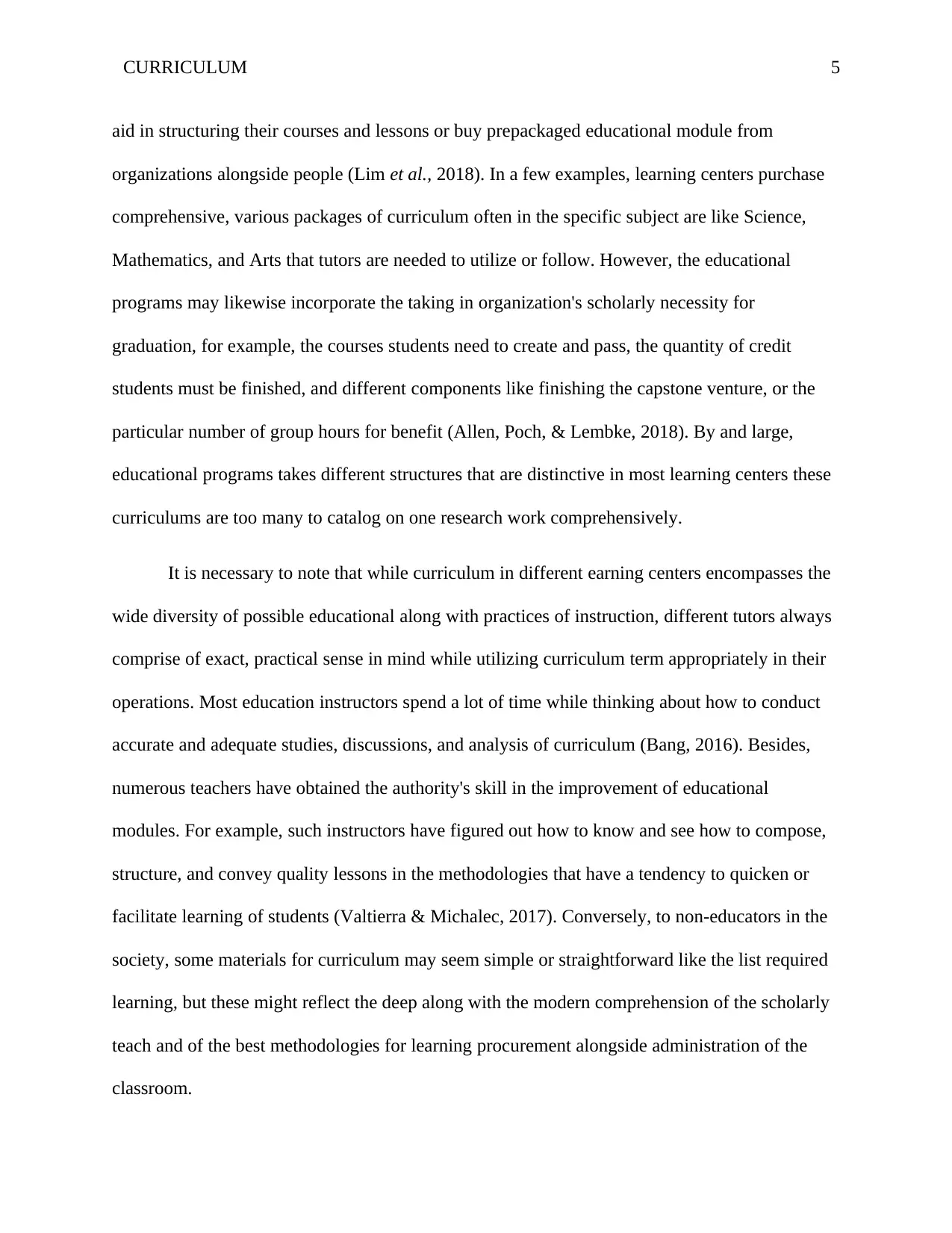
CURRICULUM 5
aid in structuring their courses and lessons or buy prepackaged educational module from
organizations alongside people (Lim et al., 2018). In a few examples, learning centers purchase
comprehensive, various packages of curriculum often in the specific subject are like Science,
Mathematics, and Arts that tutors are needed to utilize or follow. However, the educational
programs may likewise incorporate the taking in organization's scholarly necessity for
graduation, for example, the courses students need to create and pass, the quantity of credit
students must be finished, and different components like finishing the capstone venture, or the
particular number of group hours for benefit (Allen, Poch, & Lembke, 2018). By and large,
educational programs takes different structures that are distinctive in most learning centers these
curriculums are too many to catalog on one research work comprehensively.
It is necessary to note that while curriculum in different earning centers encompasses the
wide diversity of possible educational along with practices of instruction, different tutors always
comprise of exact, practical sense in mind while utilizing curriculum term appropriately in their
operations. Most education instructors spend a lot of time while thinking about how to conduct
accurate and adequate studies, discussions, and analysis of curriculum (Bang, 2016). Besides,
numerous teachers have obtained the authority's skill in the improvement of educational
modules. For example, such instructors have figured out how to know and see how to compose,
structure, and convey quality lessons in the methodologies that have a tendency to quicken or
facilitate learning of students (Valtierra & Michalec, 2017). Conversely, to non-educators in the
society, some materials for curriculum may seem simple or straightforward like the list required
learning, but these might reflect the deep along with the modern comprehension of the scholarly
teach and of the best methodologies for learning procurement alongside administration of the
classroom.
aid in structuring their courses and lessons or buy prepackaged educational module from
organizations alongside people (Lim et al., 2018). In a few examples, learning centers purchase
comprehensive, various packages of curriculum often in the specific subject are like Science,
Mathematics, and Arts that tutors are needed to utilize or follow. However, the educational
programs may likewise incorporate the taking in organization's scholarly necessity for
graduation, for example, the courses students need to create and pass, the quantity of credit
students must be finished, and different components like finishing the capstone venture, or the
particular number of group hours for benefit (Allen, Poch, & Lembke, 2018). By and large,
educational programs takes different structures that are distinctive in most learning centers these
curriculums are too many to catalog on one research work comprehensively.
It is necessary to note that while curriculum in different earning centers encompasses the
wide diversity of possible educational along with practices of instruction, different tutors always
comprise of exact, practical sense in mind while utilizing curriculum term appropriately in their
operations. Most education instructors spend a lot of time while thinking about how to conduct
accurate and adequate studies, discussions, and analysis of curriculum (Bang, 2016). Besides,
numerous teachers have obtained the authority's skill in the improvement of educational
modules. For example, such instructors have figured out how to know and see how to compose,
structure, and convey quality lessons in the methodologies that have a tendency to quicken or
facilitate learning of students (Valtierra & Michalec, 2017). Conversely, to non-educators in the
society, some materials for curriculum may seem simple or straightforward like the list required
learning, but these might reflect the deep along with the modern comprehension of the scholarly
teach and of the best methodologies for learning procurement alongside administration of the
classroom.
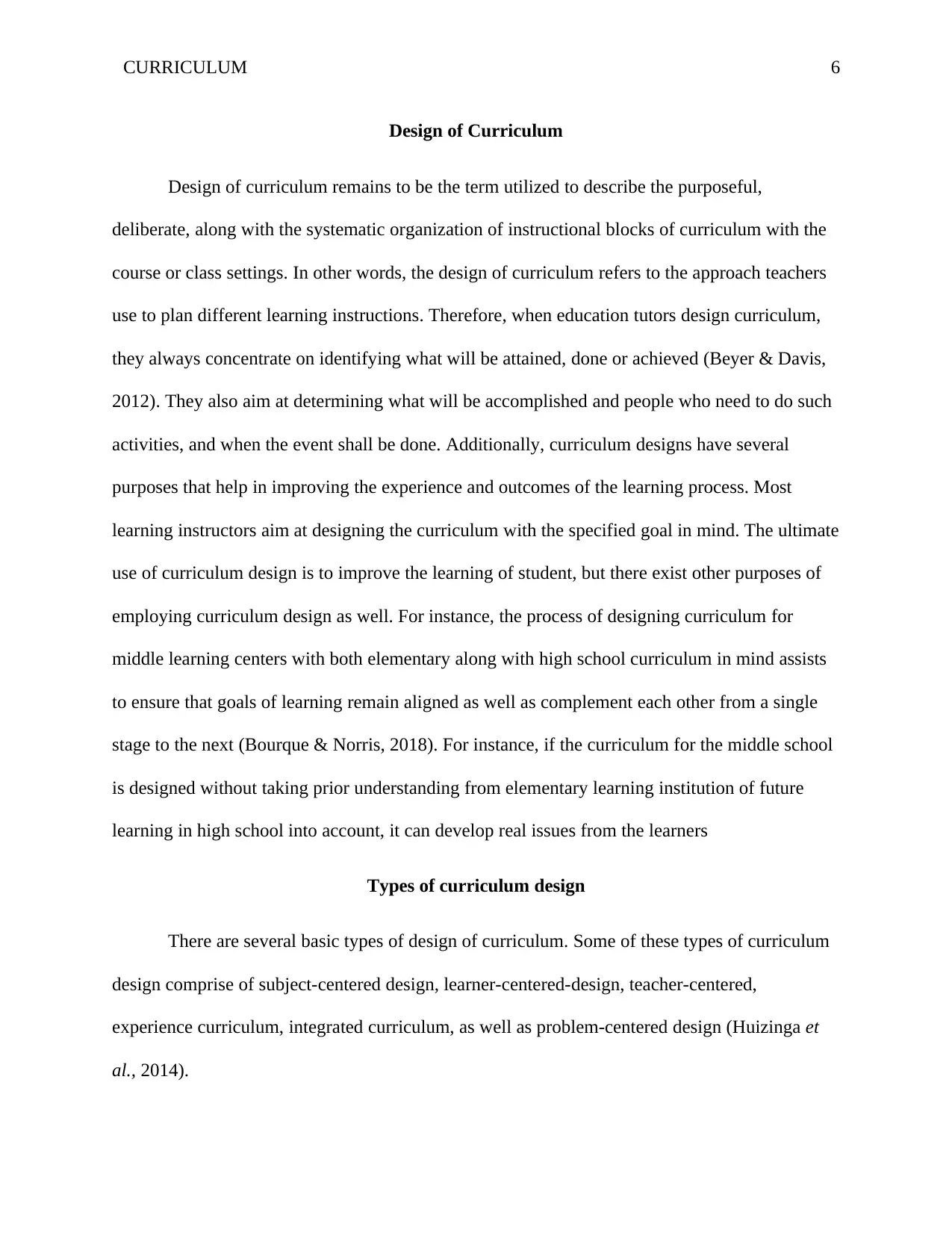
CURRICULUM 6
Design of Curriculum
Design of curriculum remains to be the term utilized to describe the purposeful,
deliberate, along with the systematic organization of instructional blocks of curriculum with the
course or class settings. In other words, the design of curriculum refers to the approach teachers
use to plan different learning instructions. Therefore, when education tutors design curriculum,
they always concentrate on identifying what will be attained, done or achieved (Beyer & Davis,
2012). They also aim at determining what will be accomplished and people who need to do such
activities, and when the event shall be done. Additionally, curriculum designs have several
purposes that help in improving the experience and outcomes of the learning process. Most
learning instructors aim at designing the curriculum with the specified goal in mind. The ultimate
use of curriculum design is to improve the learning of student, but there exist other purposes of
employing curriculum design as well. For instance, the process of designing curriculum for
middle learning centers with both elementary along with high school curriculum in mind assists
to ensure that goals of learning remain aligned as well as complement each other from a single
stage to the next (Bourque & Norris, 2018). For instance, if the curriculum for the middle school
is designed without taking prior understanding from elementary learning institution of future
learning in high school into account, it can develop real issues from the learners
Types of curriculum design
There are several basic types of design of curriculum. Some of these types of curriculum
design comprise of subject-centered design, learner-centered-design, teacher-centered,
experience curriculum, integrated curriculum, as well as problem-centered design (Huizinga et
al., 2014).
Design of Curriculum
Design of curriculum remains to be the term utilized to describe the purposeful,
deliberate, along with the systematic organization of instructional blocks of curriculum with the
course or class settings. In other words, the design of curriculum refers to the approach teachers
use to plan different learning instructions. Therefore, when education tutors design curriculum,
they always concentrate on identifying what will be attained, done or achieved (Beyer & Davis,
2012). They also aim at determining what will be accomplished and people who need to do such
activities, and when the event shall be done. Additionally, curriculum designs have several
purposes that help in improving the experience and outcomes of the learning process. Most
learning instructors aim at designing the curriculum with the specified goal in mind. The ultimate
use of curriculum design is to improve the learning of student, but there exist other purposes of
employing curriculum design as well. For instance, the process of designing curriculum for
middle learning centers with both elementary along with high school curriculum in mind assists
to ensure that goals of learning remain aligned as well as complement each other from a single
stage to the next (Bourque & Norris, 2018). For instance, if the curriculum for the middle school
is designed without taking prior understanding from elementary learning institution of future
learning in high school into account, it can develop real issues from the learners
Types of curriculum design
There are several basic types of design of curriculum. Some of these types of curriculum
design comprise of subject-centered design, learner-centered-design, teacher-centered,
experience curriculum, integrated curriculum, as well as problem-centered design (Huizinga et
al., 2014).
⊘ This is a preview!⊘
Do you want full access?
Subscribe today to unlock all pages.

Trusted by 1+ million students worldwide
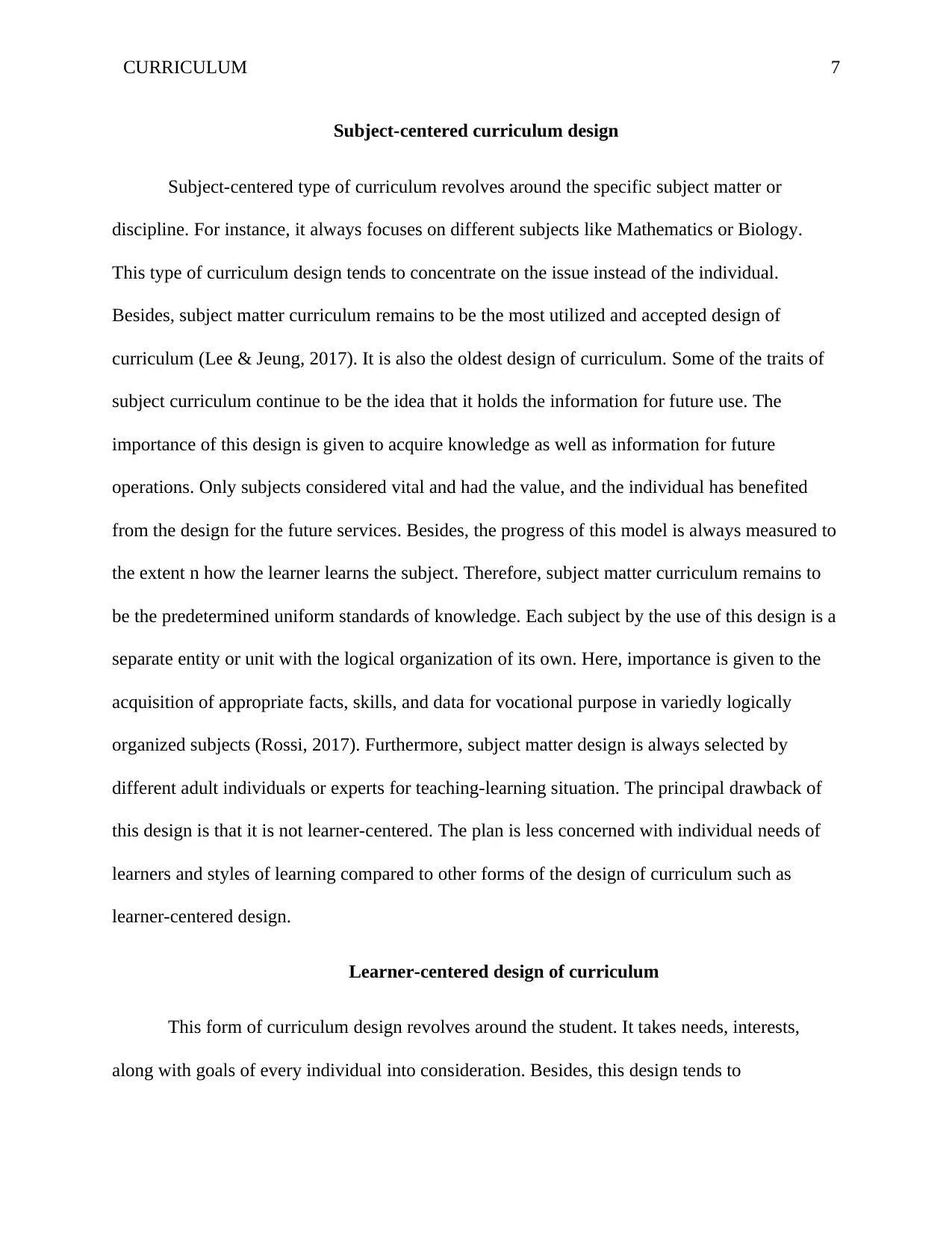
CURRICULUM 7
Subject-centered curriculum design
Subject-centered type of curriculum revolves around the specific subject matter or
discipline. For instance, it always focuses on different subjects like Mathematics or Biology.
This type of curriculum design tends to concentrate on the issue instead of the individual.
Besides, subject matter curriculum remains to be the most utilized and accepted design of
curriculum (Lee & Jeung, 2017). It is also the oldest design of curriculum. Some of the traits of
subject curriculum continue to be the idea that it holds the information for future use. The
importance of this design is given to acquire knowledge as well as information for future
operations. Only subjects considered vital and had the value, and the individual has benefited
from the design for the future services. Besides, the progress of this model is always measured to
the extent n how the learner learns the subject. Therefore, subject matter curriculum remains to
be the predetermined uniform standards of knowledge. Each subject by the use of this design is a
separate entity or unit with the logical organization of its own. Here, importance is given to the
acquisition of appropriate facts, skills, and data for vocational purpose in variedly logically
organized subjects (Rossi, 2017). Furthermore, subject matter design is always selected by
different adult individuals or experts for teaching-learning situation. The principal drawback of
this design is that it is not learner-centered. The plan is less concerned with individual needs of
learners and styles of learning compared to other forms of the design of curriculum such as
learner-centered design.
Learner-centered design of curriculum
This form of curriculum design revolves around the student. It takes needs, interests,
along with goals of every individual into consideration. Besides, this design tends to
Subject-centered curriculum design
Subject-centered type of curriculum revolves around the specific subject matter or
discipline. For instance, it always focuses on different subjects like Mathematics or Biology.
This type of curriculum design tends to concentrate on the issue instead of the individual.
Besides, subject matter curriculum remains to be the most utilized and accepted design of
curriculum (Lee & Jeung, 2017). It is also the oldest design of curriculum. Some of the traits of
subject curriculum continue to be the idea that it holds the information for future use. The
importance of this design is given to acquire knowledge as well as information for future
operations. Only subjects considered vital and had the value, and the individual has benefited
from the design for the future services. Besides, the progress of this model is always measured to
the extent n how the learner learns the subject. Therefore, subject matter curriculum remains to
be the predetermined uniform standards of knowledge. Each subject by the use of this design is a
separate entity or unit with the logical organization of its own. Here, importance is given to the
acquisition of appropriate facts, skills, and data for vocational purpose in variedly logically
organized subjects (Rossi, 2017). Furthermore, subject matter design is always selected by
different adult individuals or experts for teaching-learning situation. The principal drawback of
this design is that it is not learner-centered. The plan is less concerned with individual needs of
learners and styles of learning compared to other forms of the design of curriculum such as
learner-centered design.
Learner-centered design of curriculum
This form of curriculum design revolves around the student. It takes needs, interests,
along with goals of every individual into consideration. Besides, this design tends to
Paraphrase This Document
Need a fresh take? Get an instant paraphrase of this document with our AI Paraphraser
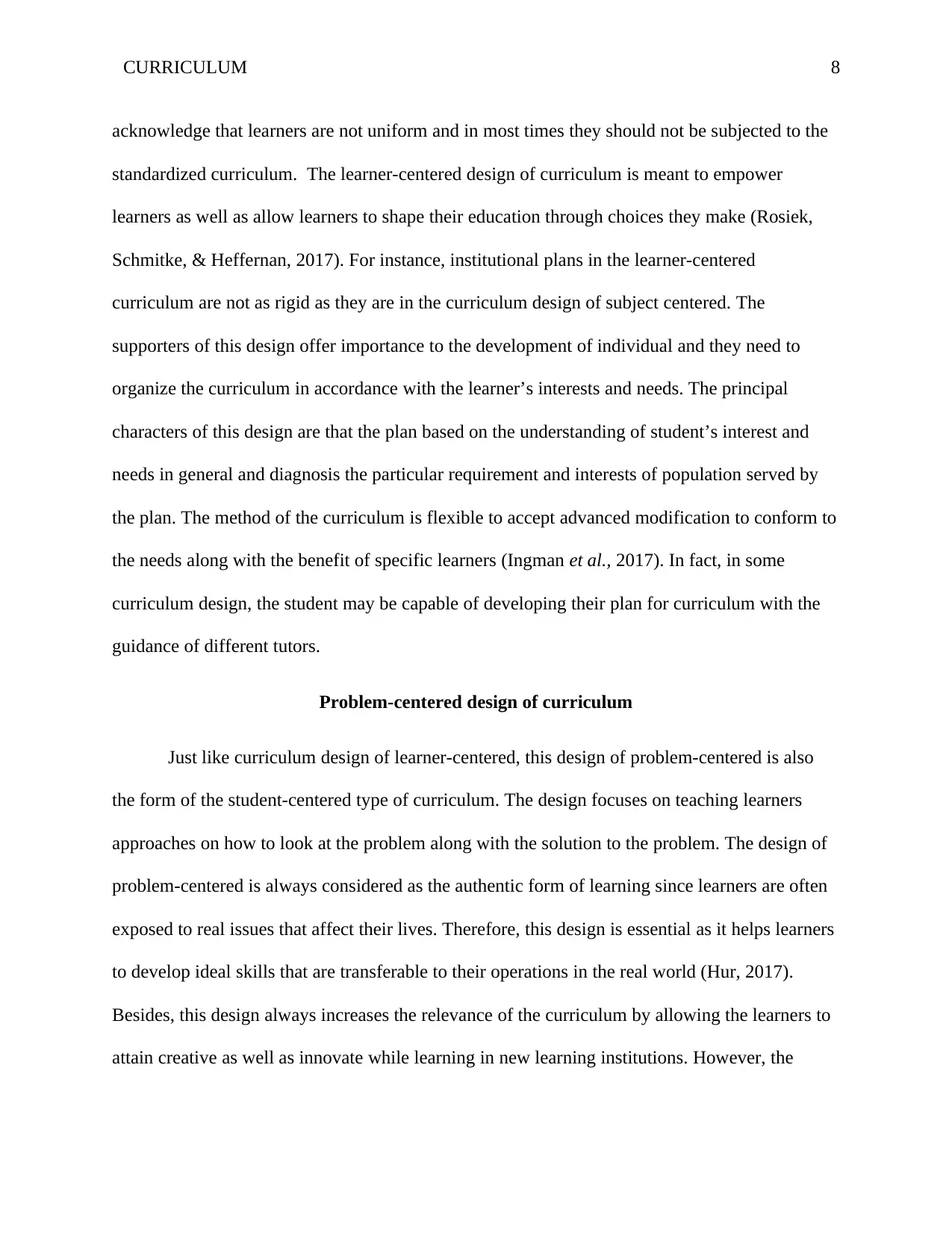
CURRICULUM 8
acknowledge that learners are not uniform and in most times they should not be subjected to the
standardized curriculum. The learner-centered design of curriculum is meant to empower
learners as well as allow learners to shape their education through choices they make (Rosiek,
Schmitke, & Heffernan, 2017). For instance, institutional plans in the learner-centered
curriculum are not as rigid as they are in the curriculum design of subject centered. The
supporters of this design offer importance to the development of individual and they need to
organize the curriculum in accordance with the learner’s interests and needs. The principal
characters of this design are that the plan based on the understanding of student’s interest and
needs in general and diagnosis the particular requirement and interests of population served by
the plan. The method of the curriculum is flexible to accept advanced modification to conform to
the needs along with the benefit of specific learners (Ingman et al., 2017). In fact, in some
curriculum design, the student may be capable of developing their plan for curriculum with the
guidance of different tutors.
Problem-centered design of curriculum
Just like curriculum design of learner-centered, this design of problem-centered is also
the form of the student-centered type of curriculum. The design focuses on teaching learners
approaches on how to look at the problem along with the solution to the problem. The design of
problem-centered is always considered as the authentic form of learning since learners are often
exposed to real issues that affect their lives. Therefore, this design is essential as it helps learners
to develop ideal skills that are transferable to their operations in the real world (Hur, 2017).
Besides, this design always increases the relevance of the curriculum by allowing the learners to
attain creative as well as innovate while learning in new learning institutions. However, the
acknowledge that learners are not uniform and in most times they should not be subjected to the
standardized curriculum. The learner-centered design of curriculum is meant to empower
learners as well as allow learners to shape their education through choices they make (Rosiek,
Schmitke, & Heffernan, 2017). For instance, institutional plans in the learner-centered
curriculum are not as rigid as they are in the curriculum design of subject centered. The
supporters of this design offer importance to the development of individual and they need to
organize the curriculum in accordance with the learner’s interests and needs. The principal
characters of this design are that the plan based on the understanding of student’s interest and
needs in general and diagnosis the particular requirement and interests of population served by
the plan. The method of the curriculum is flexible to accept advanced modification to conform to
the needs along with the benefit of specific learners (Ingman et al., 2017). In fact, in some
curriculum design, the student may be capable of developing their plan for curriculum with the
guidance of different tutors.
Problem-centered design of curriculum
Just like curriculum design of learner-centered, this design of problem-centered is also
the form of the student-centered type of curriculum. The design focuses on teaching learners
approaches on how to look at the problem along with the solution to the problem. The design of
problem-centered is always considered as the authentic form of learning since learners are often
exposed to real issues that affect their lives. Therefore, this design is essential as it helps learners
to develop ideal skills that are transferable to their operations in the real world (Hur, 2017).
Besides, this design always increases the relevance of the curriculum by allowing the learners to
attain creative as well as innovate while learning in new learning institutions. However, the
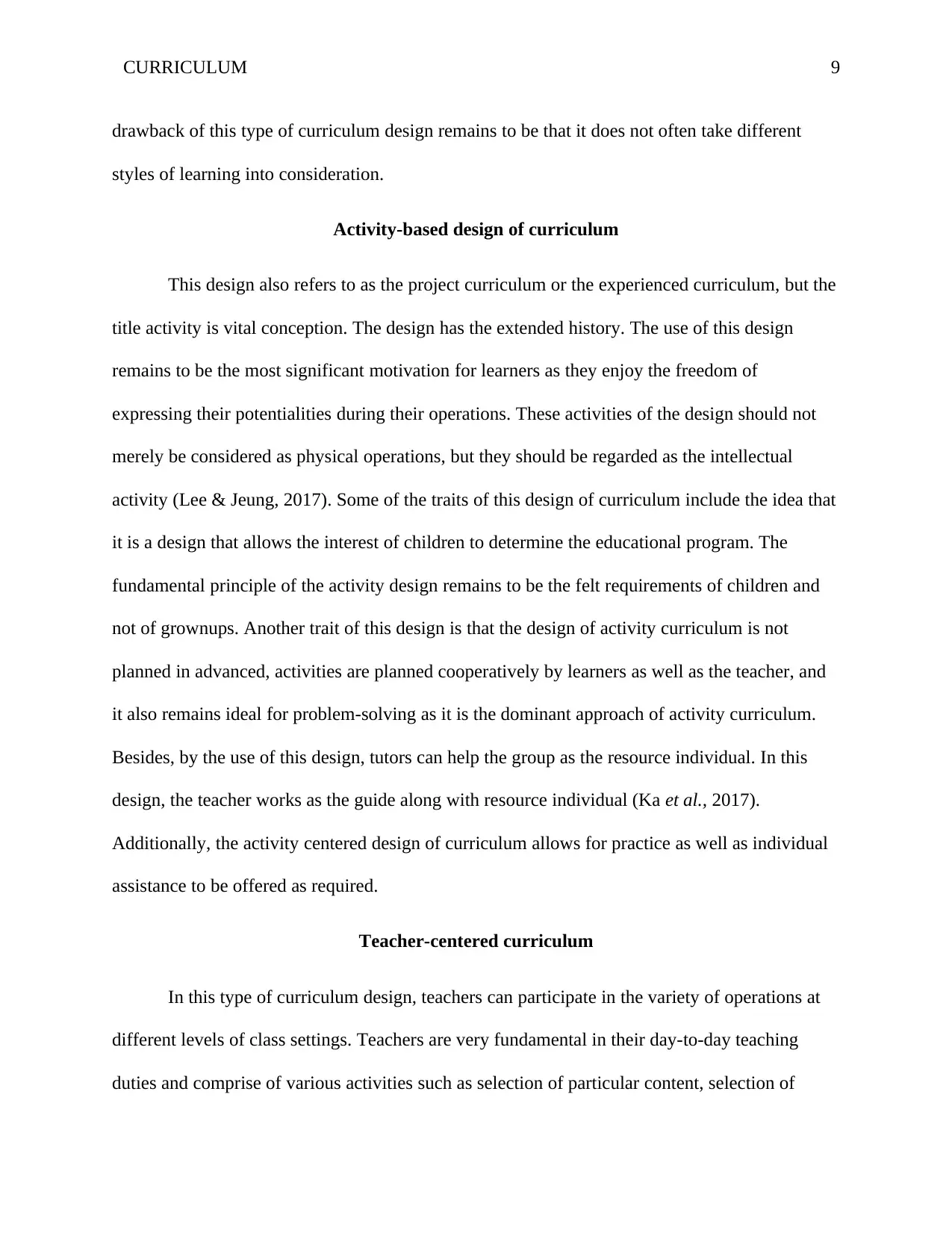
CURRICULUM 9
drawback of this type of curriculum design remains to be that it does not often take different
styles of learning into consideration.
Activity-based design of curriculum
This design also refers to as the project curriculum or the experienced curriculum, but the
title activity is vital conception. The design has the extended history. The use of this design
remains to be the most significant motivation for learners as they enjoy the freedom of
expressing their potentialities during their operations. These activities of the design should not
merely be considered as physical operations, but they should be regarded as the intellectual
activity (Lee & Jeung, 2017). Some of the traits of this design of curriculum include the idea that
it is a design that allows the interest of children to determine the educational program. The
fundamental principle of the activity design remains to be the felt requirements of children and
not of grownups. Another trait of this design is that the design of activity curriculum is not
planned in advanced, activities are planned cooperatively by learners as well as the teacher, and
it also remains ideal for problem-solving as it is the dominant approach of activity curriculum.
Besides, by the use of this design, tutors can help the group as the resource individual. In this
design, the teacher works as the guide along with resource individual (Ka et al., 2017).
Additionally, the activity centered design of curriculum allows for practice as well as individual
assistance to be offered as required.
Teacher-centered curriculum
In this type of curriculum design, teachers can participate in the variety of operations at
different levels of class settings. Teachers are very fundamental in their day-to-day teaching
duties and comprise of various activities such as selection of particular content, selection of
drawback of this type of curriculum design remains to be that it does not often take different
styles of learning into consideration.
Activity-based design of curriculum
This design also refers to as the project curriculum or the experienced curriculum, but the
title activity is vital conception. The design has the extended history. The use of this design
remains to be the most significant motivation for learners as they enjoy the freedom of
expressing their potentialities during their operations. These activities of the design should not
merely be considered as physical operations, but they should be regarded as the intellectual
activity (Lee & Jeung, 2017). Some of the traits of this design of curriculum include the idea that
it is a design that allows the interest of children to determine the educational program. The
fundamental principle of the activity design remains to be the felt requirements of children and
not of grownups. Another trait of this design is that the design of activity curriculum is not
planned in advanced, activities are planned cooperatively by learners as well as the teacher, and
it also remains ideal for problem-solving as it is the dominant approach of activity curriculum.
Besides, by the use of this design, tutors can help the group as the resource individual. In this
design, the teacher works as the guide along with resource individual (Ka et al., 2017).
Additionally, the activity centered design of curriculum allows for practice as well as individual
assistance to be offered as required.
Teacher-centered curriculum
In this type of curriculum design, teachers can participate in the variety of operations at
different levels of class settings. Teachers are very fundamental in their day-to-day teaching
duties and comprise of various activities such as selection of particular content, selection of
⊘ This is a preview!⊘
Do you want full access?
Subscribe today to unlock all pages.

Trusted by 1+ million students worldwide
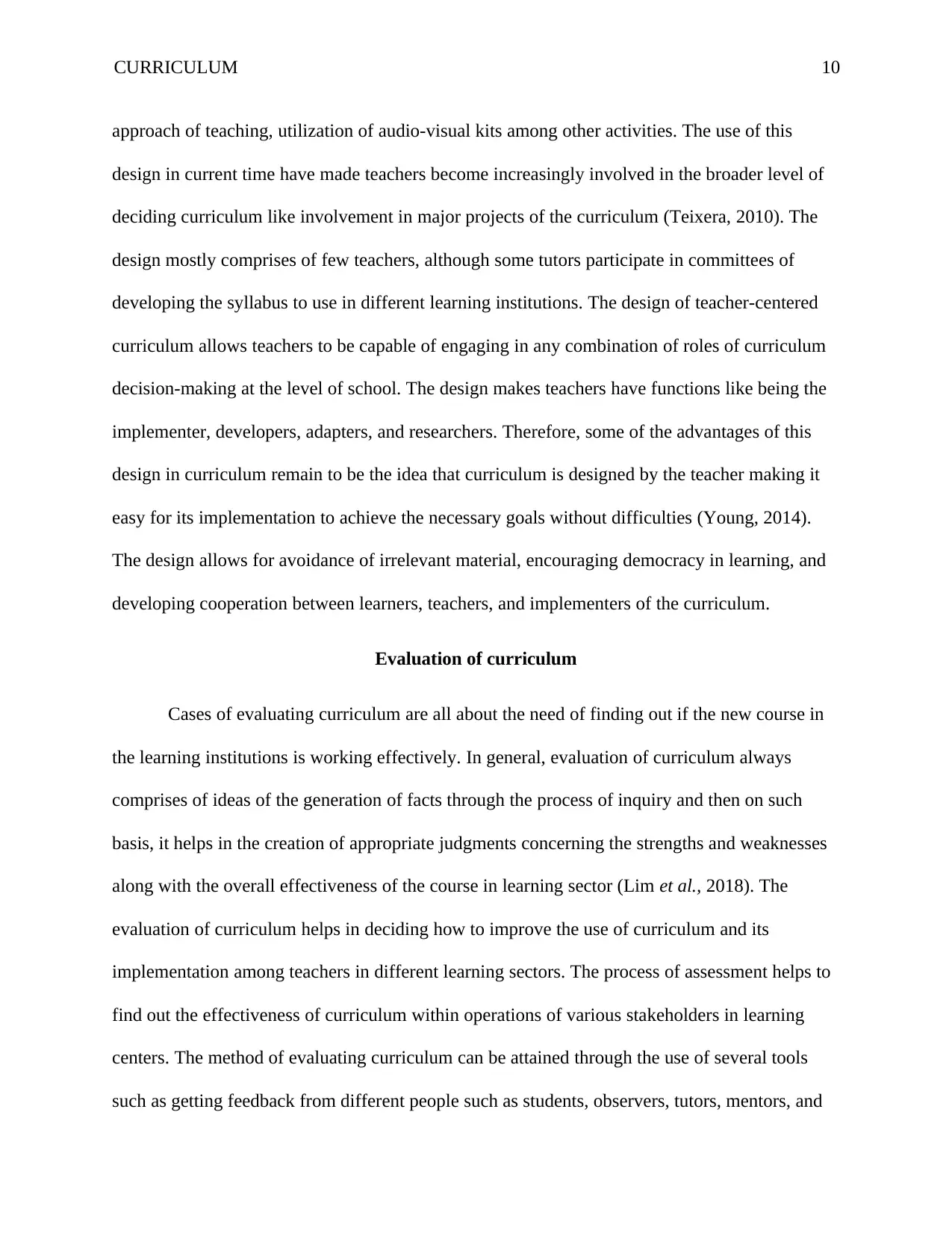
CURRICULUM 10
approach of teaching, utilization of audio-visual kits among other activities. The use of this
design in current time have made teachers become increasingly involved in the broader level of
deciding curriculum like involvement in major projects of the curriculum (Teixera, 2010). The
design mostly comprises of few teachers, although some tutors participate in committees of
developing the syllabus to use in different learning institutions. The design of teacher-centered
curriculum allows teachers to be capable of engaging in any combination of roles of curriculum
decision-making at the level of school. The design makes teachers have functions like being the
implementer, developers, adapters, and researchers. Therefore, some of the advantages of this
design in curriculum remain to be the idea that curriculum is designed by the teacher making it
easy for its implementation to achieve the necessary goals without difficulties (Young, 2014).
The design allows for avoidance of irrelevant material, encouraging democracy in learning, and
developing cooperation between learners, teachers, and implementers of the curriculum.
Evaluation of curriculum
Cases of evaluating curriculum are all about the need of finding out if the new course in
the learning institutions is working effectively. In general, evaluation of curriculum always
comprises of ideas of the generation of facts through the process of inquiry and then on such
basis, it helps in the creation of appropriate judgments concerning the strengths and weaknesses
along with the overall effectiveness of the course in learning sector (Lim et al., 2018). The
evaluation of curriculum helps in deciding how to improve the use of curriculum and its
implementation among teachers in different learning sectors. The process of assessment helps to
find out the effectiveness of curriculum within operations of various stakeholders in learning
centers. The method of evaluating curriculum can be attained through the use of several tools
such as getting feedback from different people such as students, observers, tutors, mentors, and
approach of teaching, utilization of audio-visual kits among other activities. The use of this
design in current time have made teachers become increasingly involved in the broader level of
deciding curriculum like involvement in major projects of the curriculum (Teixera, 2010). The
design mostly comprises of few teachers, although some tutors participate in committees of
developing the syllabus to use in different learning institutions. The design of teacher-centered
curriculum allows teachers to be capable of engaging in any combination of roles of curriculum
decision-making at the level of school. The design makes teachers have functions like being the
implementer, developers, adapters, and researchers. Therefore, some of the advantages of this
design in curriculum remain to be the idea that curriculum is designed by the teacher making it
easy for its implementation to achieve the necessary goals without difficulties (Young, 2014).
The design allows for avoidance of irrelevant material, encouraging democracy in learning, and
developing cooperation between learners, teachers, and implementers of the curriculum.
Evaluation of curriculum
Cases of evaluating curriculum are all about the need of finding out if the new course in
the learning institutions is working effectively. In general, evaluation of curriculum always
comprises of ideas of the generation of facts through the process of inquiry and then on such
basis, it helps in the creation of appropriate judgments concerning the strengths and weaknesses
along with the overall effectiveness of the course in learning sector (Lim et al., 2018). The
evaluation of curriculum helps in deciding how to improve the use of curriculum and its
implementation among teachers in different learning sectors. The process of assessment helps to
find out the effectiveness of curriculum within operations of various stakeholders in learning
centers. The method of evaluating curriculum can be attained through the use of several tools
such as getting feedback from different people such as students, observers, tutors, mentors, and
Paraphrase This Document
Need a fresh take? Get an instant paraphrase of this document with our AI Paraphraser
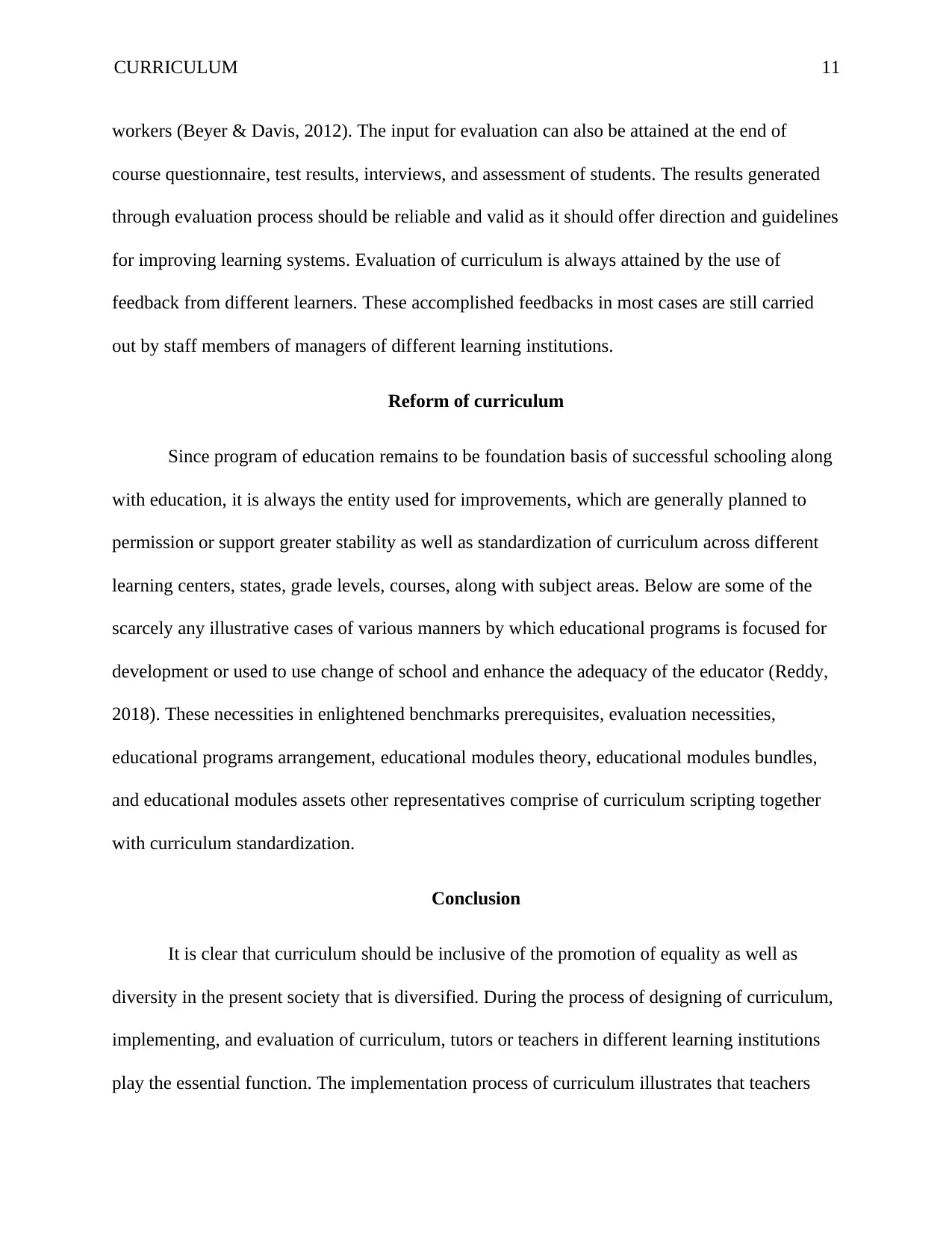
CURRICULUM 11
workers (Beyer & Davis, 2012). The input for evaluation can also be attained at the end of
course questionnaire, test results, interviews, and assessment of students. The results generated
through evaluation process should be reliable and valid as it should offer direction and guidelines
for improving learning systems. Evaluation of curriculum is always attained by the use of
feedback from different learners. These accomplished feedbacks in most cases are still carried
out by staff members of managers of different learning institutions.
Reform of curriculum
Since program of education remains to be foundation basis of successful schooling along
with education, it is always the entity used for improvements, which are generally planned to
permission or support greater stability as well as standardization of curriculum across different
learning centers, states, grade levels, courses, along with subject areas. Below are some of the
scarcely any illustrative cases of various manners by which educational programs is focused for
development or used to use change of school and enhance the adequacy of the educator (Reddy,
2018). These necessities in enlightened benchmarks prerequisites, evaluation necessities,
educational programs arrangement, educational modules theory, educational modules bundles,
and educational modules assets other representatives comprise of curriculum scripting together
with curriculum standardization.
Conclusion
It is clear that curriculum should be inclusive of the promotion of equality as well as
diversity in the present society that is diversified. During the process of designing of curriculum,
implementing, and evaluation of curriculum, tutors or teachers in different learning institutions
play the essential function. The implementation process of curriculum illustrates that teachers
workers (Beyer & Davis, 2012). The input for evaluation can also be attained at the end of
course questionnaire, test results, interviews, and assessment of students. The results generated
through evaluation process should be reliable and valid as it should offer direction and guidelines
for improving learning systems. Evaluation of curriculum is always attained by the use of
feedback from different learners. These accomplished feedbacks in most cases are still carried
out by staff members of managers of different learning institutions.
Reform of curriculum
Since program of education remains to be foundation basis of successful schooling along
with education, it is always the entity used for improvements, which are generally planned to
permission or support greater stability as well as standardization of curriculum across different
learning centers, states, grade levels, courses, along with subject areas. Below are some of the
scarcely any illustrative cases of various manners by which educational programs is focused for
development or used to use change of school and enhance the adequacy of the educator (Reddy,
2018). These necessities in enlightened benchmarks prerequisites, evaluation necessities,
educational programs arrangement, educational modules theory, educational modules bundles,
and educational modules assets other representatives comprise of curriculum scripting together
with curriculum standardization.
Conclusion
It is clear that curriculum should be inclusive of the promotion of equality as well as
diversity in the present society that is diversified. During the process of designing of curriculum,
implementing, and evaluation of curriculum, tutors or teachers in different learning institutions
play the essential function. The implementation process of curriculum illustrates that teachers
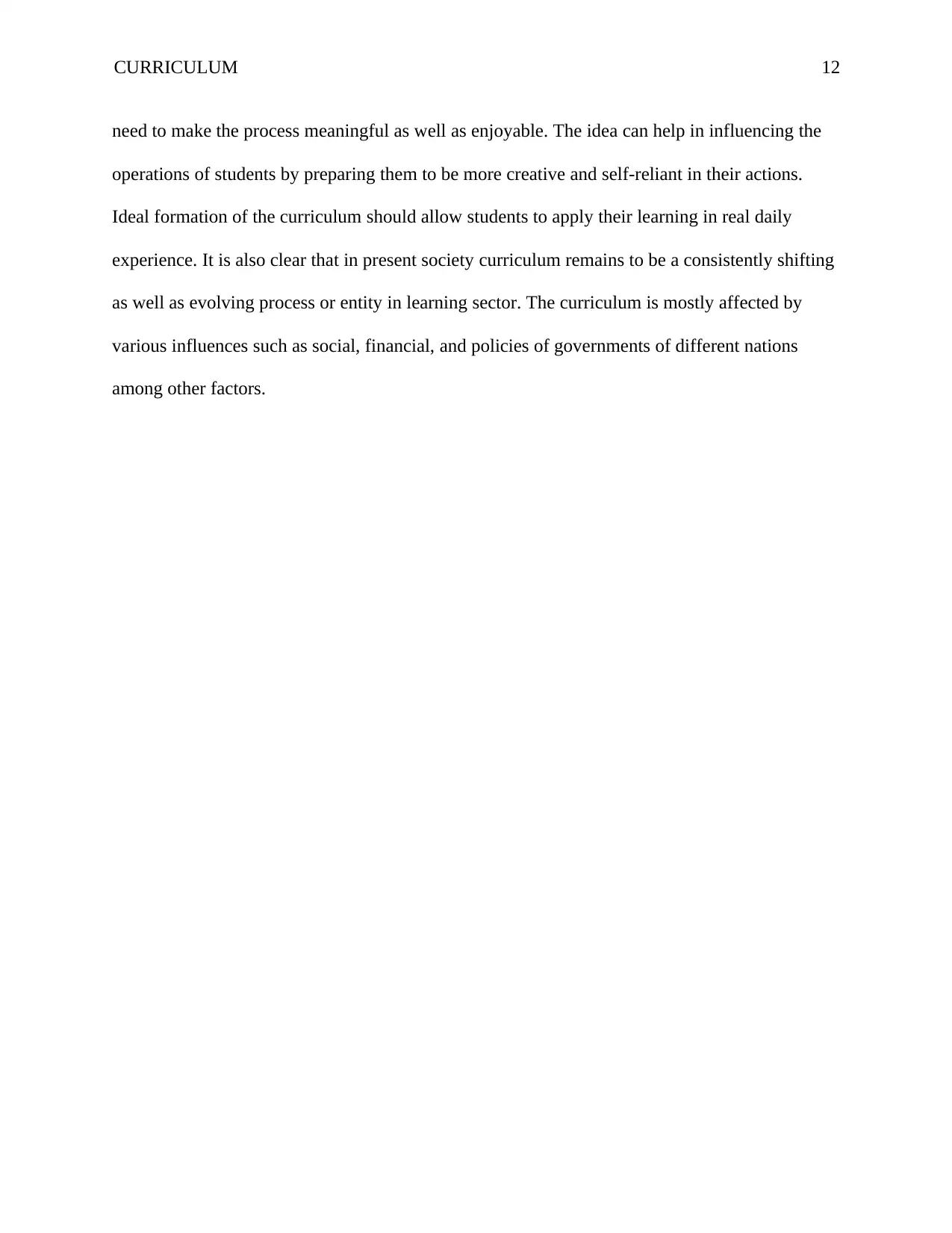
CURRICULUM 12
need to make the process meaningful as well as enjoyable. The idea can help in influencing the
operations of students by preparing them to be more creative and self-reliant in their actions.
Ideal formation of the curriculum should allow students to apply their learning in real daily
experience. It is also clear that in present society curriculum remains to be a consistently shifting
as well as evolving process or entity in learning sector. The curriculum is mostly affected by
various influences such as social, financial, and policies of governments of different nations
among other factors.
need to make the process meaningful as well as enjoyable. The idea can help in influencing the
operations of students by preparing them to be more creative and self-reliant in their actions.
Ideal formation of the curriculum should allow students to apply their learning in real daily
experience. It is also clear that in present society curriculum remains to be a consistently shifting
as well as evolving process or entity in learning sector. The curriculum is mostly affected by
various influences such as social, financial, and policies of governments of different nations
among other factors.
⊘ This is a preview!⊘
Do you want full access?
Subscribe today to unlock all pages.

Trusted by 1+ million students worldwide
1 out of 15
Related Documents
Your All-in-One AI-Powered Toolkit for Academic Success.
+13062052269
info@desklib.com
Available 24*7 on WhatsApp / Email
![[object Object]](/_next/static/media/star-bottom.7253800d.svg)
Unlock your academic potential
Copyright © 2020–2025 A2Z Services. All Rights Reserved. Developed and managed by ZUCOL.





